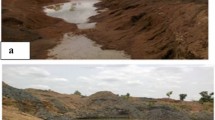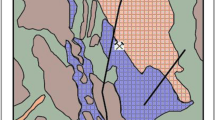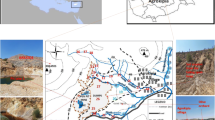Abstract
Lead, zinc, and associated minerals have been mined in the Enyigba, Nigeria area for over 92 years, leaving accumulated sulphide dumps and contaminated mine water. Stream sediment, mine tailings, mine water, stream water, and groundwater were sampled and analysed to determine the sources of potentially harmful elements in domestic water. The mine water contained mean concentrations of Cd, As, Co, Cr, Mn, Pb, and Ni that greatly exceeded those of the stream water, but samples from the streams and groundwater exceeded Nigerian drinking water and WHO thresholds for Al, Fe, and Pb, except for acceptable Pb concentrations in the borehole. Mn concentrations in one stream also exceeded Nigerian and WHO threshold for drinking water. In addition to the Pb–Zn mining, geological weathering also contributed to Pb, Al, Fe, and Mn contamination in the area.
Zusammenfassung
In der Enyigba-Region (Nigeria) werden Blei, Zink und weitere Minerale seit 92 Jahren bergbaulich gewonnen. Die Rückstände werden auf sulfidhaltigen Halden gelagert, was die Bildung von schadstoffhaltigen Grubenwasser begünstigt. In dieser Studie wurden Sedimentproben aus Vorflutern und Tailings sowie Wasserproben des Grubenabwassers und des Oberflächen- und Grundwassers untersucht, um mögliche Schadstoffquellen im genutzten Wasser zu identifizieren. Die mittleren Cd-, As-, Co-, Cr-, Mn-, Pb- und Ni- Konzentrationen des Grubenwassers liegen weit über den Werten des Oberflächenwassers. Die Proben aus dem Oberflächen- und Grundwasser liegen sowohl über den nigerianischen Trinkwasser- als auch über den WHO-Grenzwerten für Al, Fe und Pb. Ausnahmen existieren für Pb-Konzentrationen in Bohrlöchern. Die Mn-Gehalte in einem der Vorfluter übersteigen ebenfalls die gültigen Trinkwassergrenzwerte Nigerias und der WHO. Neben bergbaubedingten Freisetzungsprozessen aus dem Pb-Zn-Bergbau spielen auch geogene Verwitterungsprozesse eine Rolle, welche zusätzlich zu einer Erhöhung der Pb-, Al-, Fe- und Mn-Werte in der Region beitragen.
Resumen
El plomo, el zinc y los minerales asociados han sido extraídos en el área de Enyigba, Nigeria, durante más de 92 años, dejando relaves con sulfuro y agua de mina contaminada. Los sedimentos fluviales, los relaves de la mina, el agua de mina y las aguas superficiales y subterráneas fueron muestreados y analizados para determinar las fuentes de elementos potencialmente dañinos en el agua de consumo doméstico. El agua de la mina contenía concentraciones medias de Cd, As, Co, Cr, Mn, Pb y Ni que superaban en gran medida a las de las aguas superficiales y subterráneas pero éstas superaban los niveles aceptados para el agua potable por la legislación nigeriana y por la OMS para Al, Fe y Pb, excepto por las concentraciones aceptables de Pb en el pozo. Las concentraciones de Mn en el agua superficial también superaron los mínimos aceptados para el agua potable. Además de la minería Pb-Zn, la meteorización geológica también contribuyó a la contaminación por Pb, Al, Fe y Mn en el área.
抽象
尼日利亚Enyigba的铅、锌及其它矿物开采历史已经92年,遗留大量含硫化物的固体废物和污染的采矿废水。采集和测试了研究区河底污泥、尾矿、采矿废水、河水和地下水以识别生活用水的潜在有害元素污染源。采矿废水的Cd、As、Co、Cr、Mn、Pb和Ni平均浓度远大于河水;除了钻孔水Pb浓度处于可容许范围,河水和地下水的Al、Fe和Pb浓度已经超过尼日利亚和世界卫生组织饮用水标准。一条河水的Mn浓度也超过了尼日利亚和世卫组织饮用水标准。除了Pb-Zn开采,地质风化也使Pb、Al、Fe和Mn浓度提高。


Similar content being viewed by others
References
Abraham MR, Susan TB (2017) Water contamination with heavy metals and trace elements from Kilembe copper mine and tailing sites in Western Uganda; implications for domestic water quality. Chemosphere 169:281–287
Adriano DC (1986) Trace elements in the terrestrial environment. Springer-Verlag, New York City
Banks D, Younger PL, Arnesen RT, Iversen ER, Banks S (1997) Mine water geochemistry: the good, the bad, the ugly. Environ Geol 32:157–174
Baptista NJA, Smith BJ, McAllister JJ (2000) Heavy metal concentrations in surface sediments in a nearshore environment, Jurujuba Sound, southeast Brazil. Environ Pollut 109:1–9
Besser JM, Leib KJ (1999) Modeling frequency of occurrence of toxic concentrations of zinc and copper in the upper Animas River. In: Morganwalp DW, Buxton HT (eds) Proceedings of Technical Meeting, U.S. Geological Survey (USGS) Toxic Substances Hydrology Program, USGS WRI Report 99-4018A, vol 1, pp 75–81
Blasco J, Sancheenz V, Gomez-Parra A (2000) Heavy metal fluxes at the sediment-water interface of three coastal ecosystems from southwest of the Iberian Peninsula. Sci Total Environ 247:189–199
Blowes DW, Ptacek CJ, Jambor JL, Weisener CG (2003) the geochemistry of acid mine drainage. In: Lollar BS (ed) Treatise on geochemistry, vol 9, Elsevier Ltd, New York, pp 149–204
Buat-Menard P, Chesselet R (1979) Variable influence of the atmospheric flux on the trace metal chemistry of oceanic suspended matter. Earth Planet Sci Lett 42:398–411
Burgos P, Madejon E, Perez-de-Mora A, Cabrera F (2006) Spatial variability of the chemical characteristics of a trace-element-contaminated soil before and after remediation. Geoderma 130:157–175
Burt R, Weber T, Park S, Yochum S, Ferguson R (2011) Trace element concentration and speciation in selected mining-contaminated soils and water in Willow Creek flood plain, Colorado. Appl Environ Soil Sci. https://doi.org/10.1155/2011/237071
Conesa HM, Robinson BH, Schulin R, Nowack B (2008) Metal extractability in acidic and neutral mine tailings from the Cartagena-La Union Mining District (SE Spain). Appl Geochem 23:1232–1240
Diamond JM, Winchester EL, Mackler DG, Rasnake WJ, Fanelli JK, Gruber D (1992) Toxicity of cobalt to freshwater indicator species as a function of water hardness. Aquat Toxicol 22(3):163–180
FÓ§rstner U, Wittmann GTW (1981) Metal pollution in the aquatic environment. Springer-Verlag, Berlin
Gunsinger MR, Ptacek CJ, Blowes DW, Jambor JL (2006) Evaluation of the long term sulfide oxidation processes within pyrrhotite-rich tailings, Lynn Lake, Manitoba. J Contam Hydrol 83:149–170
Hallberg KB, Johnson DB (2005) Biological manganese removal from acid mine drainage in constructed wetlands and prototype bioreactors. Sci Total Environ 338:115–124
Hartwig T, Owor MA, Zachmann D, Pohl W (2005) Lake George as a sink for contaminants derived from Kilembe copper mining area, western Uganda. Mine Water Environ 24:114–124
Holmstrom H, Ohlande B (2001) Layers rich in Fe- and Mn-oxyhydroxides formed at the tailings-pond water interface, a possible trap for trace elements in flooded mine tailings. J Geochem Explor 74:189–203
Khan S, Cao Q, Zheng YM, Huang YZ, Zhu YG (2008) Health risks of heavy metals in contaminated soils and food crops irrigated with wastewater in Beijing, China. Environ Pollut 152:686–692
Khan S, Rehman S, Khan AZ, Khan MA, Shah MT (2010) Soil and vegetables enrichment with heavy metals from geological sources in Gilgit, northern Pakistan. Ecotoxicol Environ Saf 73:1820–1827
Kribek B (2013) Recommendations for the collection and processing of samples when assessing the degree and extent of contamination of surface and ground waters, stream sediments, soils, and vegetation in areas affected by mining and mineral processing in countries of Sub-Saharan Africa. Unpublished Report. SIDA Project Planing Meeting, 2013. Prague, Czech Republic, pp 1–6
Lacatuso R (1998) Appraising levels of soil contamination and pollution with heavy metals. European Soil Bureau Research Report No. 4, pp 393–399
Lee G, Bingham JM, Faure G (2002) Removal of trace metals by co-precipitation with Fe, Al and Mn from natural waters contaminated with acid mine drainage in the Ducktown mining district, Tennessee. Appl Geochem 17:569–581
Li Z, Ma Z, Jan Van Der Kuijp T, Yuan Z, Huang L (2014) A review of soil heavy metal pollution from mines in China: pollution and health risk assessment. Sci Total Enviro 468–469:843–853
Martin J, Meybeck M (1979) Elemental mass-balance of material carried by major world rivers. Mar Chem 7:173–206
Martinez-Martinez S, Acosta JA, Fazcano A, Carmona DM, Zornoza R, Cerda C (2013) Assessment of the lead and zinc contents in natural soils and tailing ponds from the Cartagena- La Union mining district, SE Spain. J Geochem Explor 124:166–175
McLennan MS (2001) Relationships between the trace element composition of sedimentary rocks and upper continental crust. Geochem Geophys Geosyt. https://doi.org/10.1029/2000GC000109
Moreno-Jiménez E, Penalosa JM, Manzano R, Carpena-Ruiz RO, Gamarra R, Esteban E (2009) Heavy metals distribution in soils surrounding an abandoned mine in NW Madrid (Spain) and their transference to wildflora. J Hazard Mater 162:854–859
Munk LA, Gunter F, Douglas E, Jerry P, Bigham M (2002) Sorption of trace metals to an aluminium precipitate in a stream receiving acid rock-drainage; Snake River, Summit County, Colorado. Appl Geochem 1:421–430
Musah SN, Maxiwel A, Boateng A (2013) Health risks of heavy metals in selected crops cultivated in small-scale gold-mining areas in Wassa-Amenfi-west district of Ghana. J Nat Sci Res 3(5):2224–3186
Mwesigye AR, Young SD, Bailey EH, Tumwebaze SB (2016) Population exposure to trace elements in the Kilembe copper mine area, western Uganda: a pilot study. Sci Total Environ 573:366–375
Nieto JM, Sarmiento AM, Olías M, Canovas CR, Riba I, Kalman J, Delvalls TA (2007) Acid mine drainage pollution in the Tinto and Odiel rivers (Iberian pyrite belt, SW Spain) and bioavailability of the transported metals to the Huelva estuary. Environ Int 33:445–456
Obiora SC (2012) Mapping of abandoned mines in Nigeria. In: Presentation, 2nd Workshop, IGCP/SIDA/UNESCO Project held at the NODA HOTEL, Kumasi, Ghana, 27–30 June 2012
Obiora SC, Chukwu A, Davies TC (2016a) Heavy metals and health risk assessment of arable soils and food crops around Pb–Zn mining localities in Enyigba, southeastern Nigeria. J Afr Earth Sci 116:182–189
Obiora SC, Chukwu A, Toteu SF, Davies TC (2016b) Assessment of heavy metal contamination in soils around Lead (Pb)–Zinc (Zn) mining areas in Enyigba, southeastern Nigeria. J Geol Soc India 87:453–462
Owor M, Hartwig T, Muwanga A, Zachmann D, Pohl W (2007) Impact of tailings from the Kilembe copper mining district on Lake George, Uganda. Environ Geol 51:1065–1075
Rubio B, Nombela MA, Vilas F (2000) Geochemistry of major and trace elements in sediments of the Ria de Vigo (NW Spain): an assessment of metal pollution. Mar Pollut Bull 40:968–980
SON (Standard Organization of Nigeria) (2007) Nigerian standard for drinking water quality. https://www.unicef.org. Accessed 5 Jan 2017
Stumm W, Morgan J (1981) Aquatic chemistry, second edn. Willey, New York, p 780
UK Drinking Water Inspectorate (2010) Drinking water standards. http://www.dwi.gov.uk. Accessed 14 Jan 2016
Umeji AC (2000) Evolution of the Abakaliki and the Anambra Basins, Southeastern Nigeria. A report submitted to the Shell Petroleum Development Company Nigeria Limited, pp 155
US EPA (2016) Table of regulated drinking water contaminants. https://www.epa.gov/your-drinkingwater/table-regulated-drinking-water-contaminants. Accessed 14 Jan 2016
WHO (World Health Organization) (2008) Guidelines for drinking water quality. World Health Organization, Geneva
Wisconsin Department of Natural Resources (2011) Drinking water and groundwater quality standards/advisory levels
Xiangdong L, Zhengou S, Onyx WH, Yok-Sheung (2001) Chemical forms of Pb, Zn, and Cu in the sediment profile of the Pearl River estuary. Mar Pollut Bull 42:215–223
Zhang J, Liu CL (2002) Riverine composition and estuarine geochemistry of particulate metals in China-weathering features, anthropogenic impact and chemical fluxes. Estuar Coast Mar Sci 54:1051–1070
Acknowledgements
The authors thank Dr S. Felix Toteu, leader of the UNESCO-SIDA-sponsored project, for his approval of this project. This work is part of the UNESCO-SIDA sponsored Project 503RAF2000 on ‘Abandoned Mines in Sub-Saharan African Countries’, which itself is an offshoot of the IGCP-SIDA Projects 594 and 606. The authors appreciate the Chief editor B. Kleinmann and co-reviewers for their constructive reviews.
Author information
Authors and Affiliations
Corresponding author
Rights and permissions
About this article
Cite this article
Obiora, S.C., Chukwu, A. & Davies, T.C. Contamination of the Potable Water Supply in the Lead–Zinc Mining Communities of Enyigba, Southeastern Nigeria. Mine Water Environ 38, 148–157 (2019). https://doi.org/10.1007/s10230-018-0550-0
Received:
Accepted:
Published:
Issue Date:
DOI: https://doi.org/10.1007/s10230-018-0550-0




